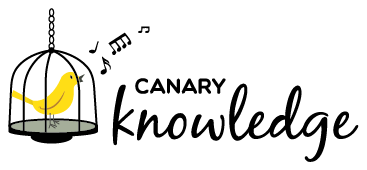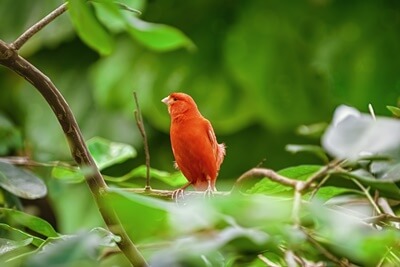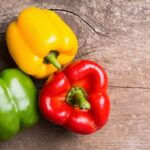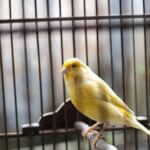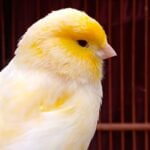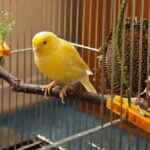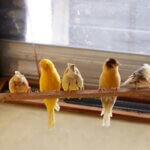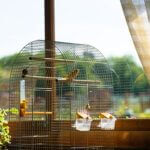Canaries sometimes change color, so many believe yellow canaries can turn red. Even with drastic dietary changes, you can’t turn a yellow canary (with homozygous alleles) into a red-factor canary.
A canary must be genetically predisposed to red feathers to turn red.
Yellow canaries with recessive red genes (heterozygous) can turn red when exposed to certain conditions. However, you must maintain these conditions to prevent it from losing its red color.
How Did Red-Factor Canaries Originate?
Red-factor canaries are the result of hybridizing the yellow canary and the red siskin bird. According to the National Institute of Health, this was the first case of genetic engineering.
The main goal of the German scientists (Duncker and Karl Reich) was to enrich the yellow canaries with the siskin’s melanin expression without transferring other characteristics.
They bred the two species to achieve this and backcrossed the new hybrid birds with yellow canaries.
The result was birds that looked like yellow canaries but retained the red allele of their siskin ancestors. This would occur after the canaries were exposed to certain foods and environmental conditions.
According to Current Biology, the CYP2J19 gene responsible for the color changes was identified. The gene is present in several color-changing bird species, including red siskins, flamingos, and zebra finches.
While it’s present in all canaries, the CYP2J19 is about a thousand times more active in red-factor canaries.
The gene is more active in the skin and liver, which are the two organs involved in transforming the yellow chemicals from carotenoids into ketocarotenoids.
The latter is the red chemicals absorbed in the canary’s blood, changing the color of its skin and feathers.
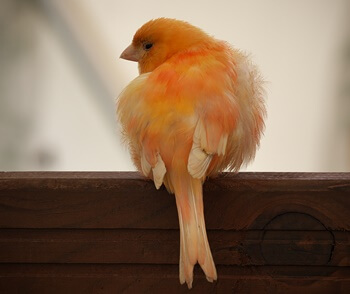
Can Yellow Canaries Turn Red?
While most yellow canaries won’t turn red, even with repeated carotenoid consumption, some seemingly yellow birds may have recessive red genes in their DNA.
Consequently, they have a higher concentration of the CYP2J19 gene. As a result, they may be susceptible to color changes when exposed to certain conditions, particularly dietary changes.
Red canaries have dominant (R) alleles (homozygous or heterozygous) or recessive homozygous (r) alleles. Meanwhile, the yellow canaries may have dominant (Y) alleles (both homozygous or heterozygous) or recessive homozygous (y) alleles.
In a heterozygous gene structure, the dominant gene gives the bird its color and other characteristics. Meanwhile, a recessive gene carries non-dominant qualities that may be difficult to notice.
A genetic predisposition of (YY) or (yy) means the canary is a homozygous yellow and can’t turn red.
A (Yr) arrangement means the canary is yellow but genetically heterozygous and can turn red when it consumes enough carotenoids. By default, a canary with a (RR) or (rr) predisposition is a red factor and will maintain a reddish color most of the time.
It’s possible that two yellow canaries can have red-factor babies, depending on their genetic traits. For instance, if two (Yr) birds mate, there is a 25% chance of their offspring being (rr) and red.
In this case, the offspring will inherit both parent’s recessive (non-dominant) red alleles to form a homozygous gene structure.
Two yellow birds can have red offspring, meaning the parents were heterozygous for that trait.
How To Identify Red-Factor Canaries
Red-factor canaries are easily recognized by their darker colors.
They may sometimes have orange, peachy, or copper hues, making them appear different from regular canaries. The latter often have bright yellow plumage.
Even when a red-factor canary isn’t well-fed, it may still be distinct from other canaries. This is because the lack of carotenoids doesn’t often remove the red color entirely; it reduces it to a pale but still recognizable hue of red.
Beyond the colors, a bird’s feathers can also tell if it is a red factor. This specific type of canary has smoother and shorter feathers than other canaries.
How To Make Canaries Red
Once you’re sure that your canary is a red factor, you can start it on a carotenoid diet to change its color. The ideal foods in this category are dark-green vegetables like:
- Kales.
- Collards.
- Broccoli.
- Lettuce.
- Spinach.
That’s in addition to any yellow or orange-colored foods certified safe for canaries, including:
- Carrots.
- Sweet potatoes.
- Pumpkins.
The latter are excellent sources of vitamin A. Green vegetables provide vitamins B, C, E, and K.
Include more of the above foods in your bird’s diet to make the color changes faster. That way, you’ll see some changes in 1-2 weeks.
When Do You Start The Feeding Program?
You should start the feeding program when the canary is almost molting to increase the likelihood of red wing development.
The molting season for canaries is usually in late summer or early fall, and the whole process may take between 6-12 weeks, depending on the bird.
If you don’t start the color-feeding at the start of the molting process, the first feathers may not be as red as you desire, and some may even be yellow. So, you’ll have to wait until the next molting to achieve a uniform red color.
If you don’t see your desired results after putting your canary on the recommended beta-carotene diet, you may want to go the canthaxanthin route. Canthaxanthin is one of the most powerful antioxidants and color-promoting substances in nature.
Although some owners and breeders use it as the sole feeding course, canthaxanthin isn’t safe or effective when used alone. Ideally, it should be combined with beta-carotenoids, with both given daily.
You should use only two tablespoons per gallon of water.
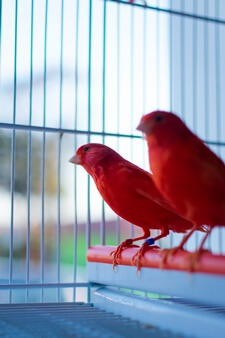
How To Keep Your Red-Factor Canary Red
Keeping your canary’s red sheen involves maintaining the carotene diet.
Aside from the standard orange and green foods, you may also want to give your canary some sprouted seeds. These are a good source of vitamin B and contain high levels of plant dyes, which can increase the intensity of the red color.
Examples of sprouted seeds that may be beneficial include:
- Pumpkin seeds.
- Red clovers.
- Flaxseed.
There are also a variety of “color foods” formulated for canaries. These foods are often made from combinations of carotenoids and can produce faster results.
Canaries molt once a year, and some birds don’t get back their red feathers. Even those who do may not get the same shade of red as before.
Allow the canary to finish its molting cycle while feeding it carotenoids. That way, the red will return.
How To Handle The Molting Period
Give the canary extra protein during molting, preferably from animal sources. These aid in the growth and development of strong, lustrous feathers and the repair of broken tissues.
Some good food options include:
- Insects.
- Eggs.
- Well-cooked meats.
You may sprinkle hemp seeds into your canary’s meals to boost protein and fatty acid levels. Considered by many as “super seeds,” hemp seeds contain the perfect balance of the following:
- Amino acids.
- Fatty acids.
- Omega 3 fats.
These are vital to feather development.
Ensure that your canary gets enough sunlight. The UV light from the sun helps with vitamin D3 development and calcium absorption.
